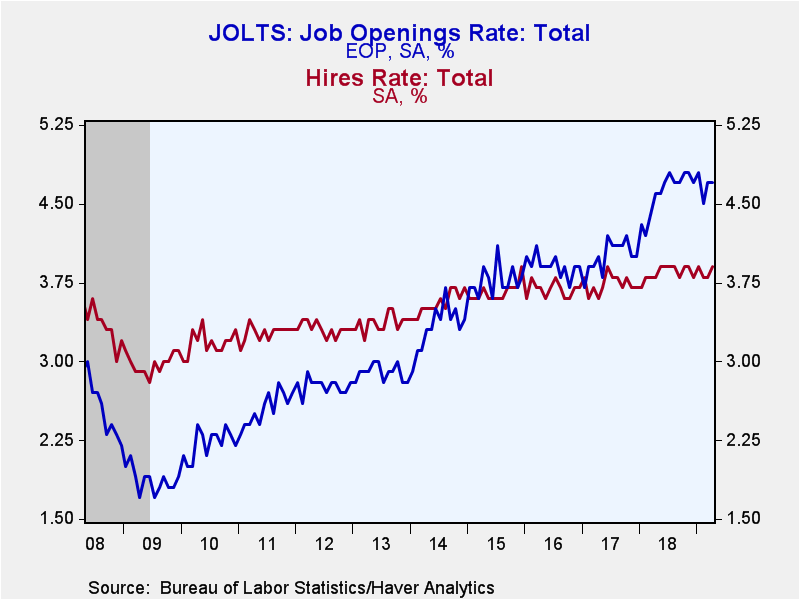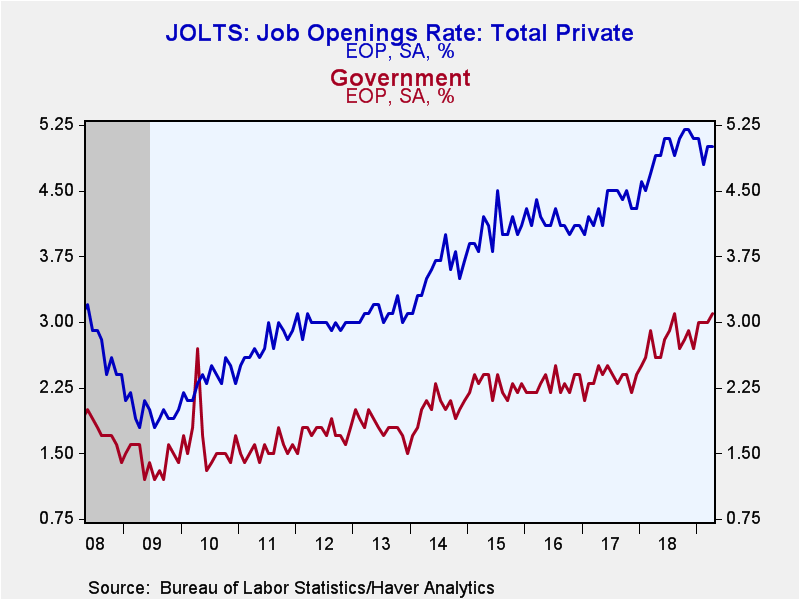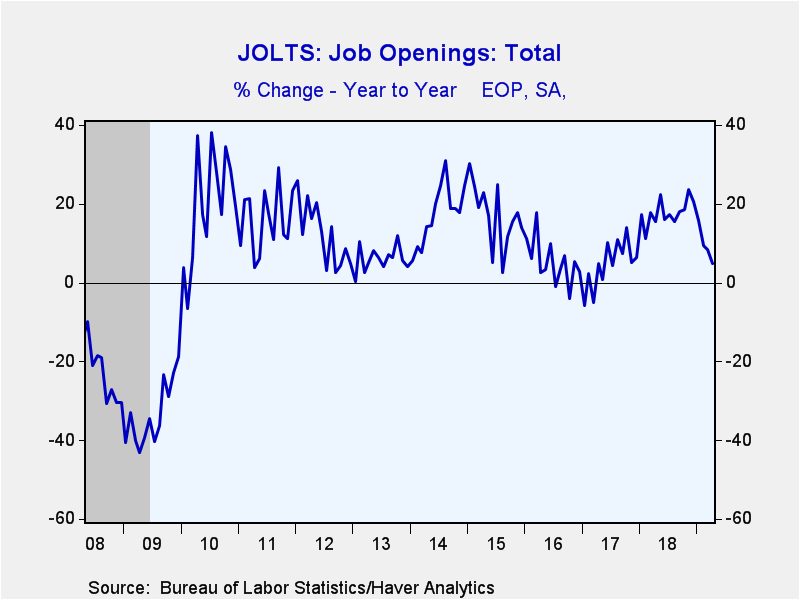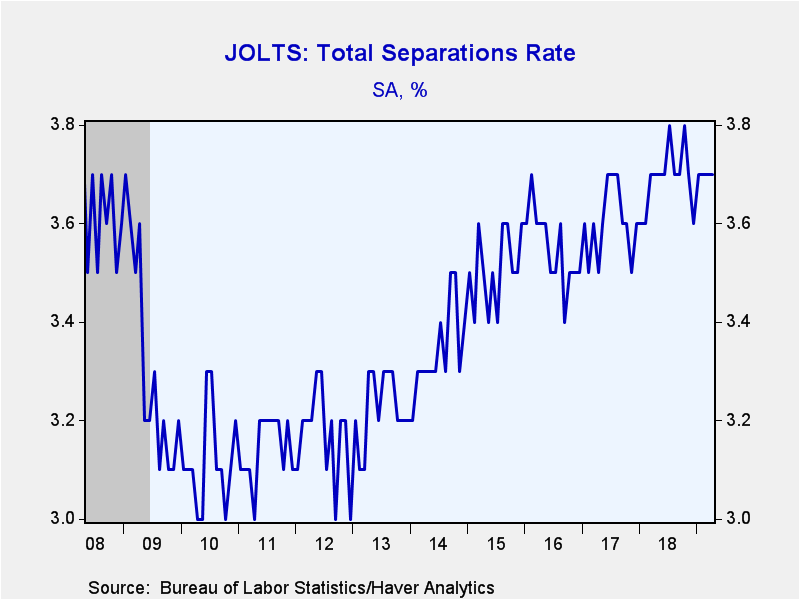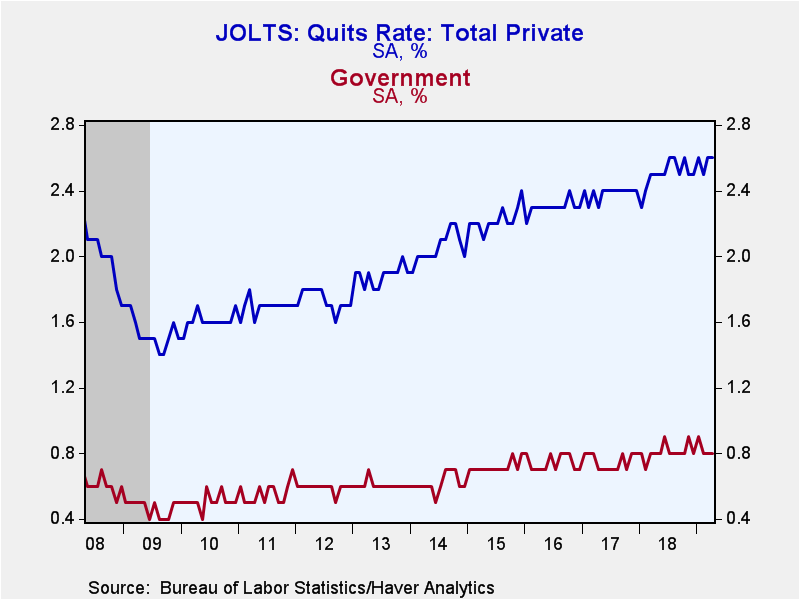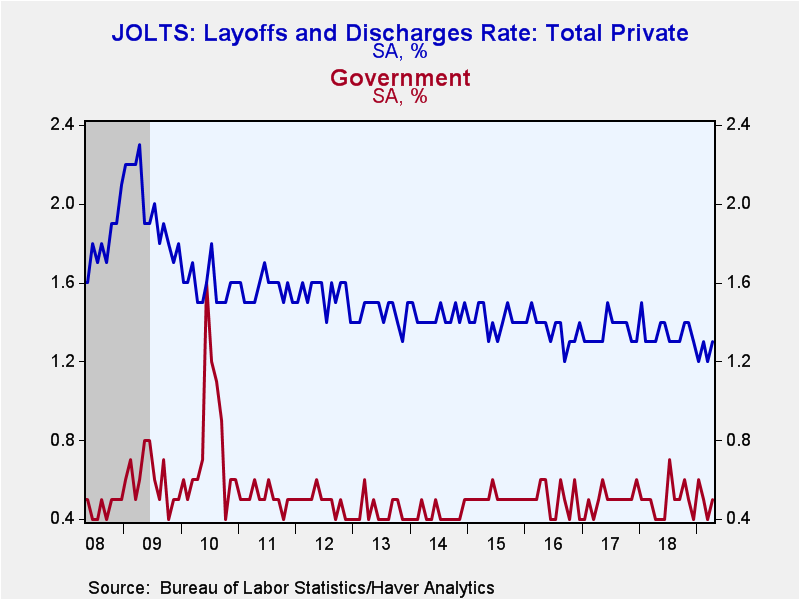 Global| Jun 10 2019
Global| Jun 10 2019U.S. JOLTS: Job Openings Stabilize; Hiring Strengthens
by:Tom Moeller
|in:Economy in Brief
Summary
The Bureau of Labor Statistics reported that the total job openings rate held at 4.7% during April, unchanged m/m but up from 4.6% twelve months earlier. It remained on the expansion's rising trend. The job openings rate is the job [...]
The Bureau of Labor Statistics reported that the total job openings rate held at 4.7% during April, unchanged m/m but up from 4.6% twelve months earlier. It remained on the expansion's rising trend. The job openings rate is the job openings level as a percent of total employment plus the job openings level. Finding workers to fill openings became easier. The hiring rate rose to a record 3.9%. Employers became somewhat more willing to let people go, as shown by the layoff & discharge rate which increased to 1.2% from the record low of 1.1% in March. Individuals remained ready to find new work. The quits rate held steady at a near-record 2.3% where it's been since June of last year.
The private-sector job openings rate held steady m/m at 5.0%, but remained below the 5.2% record reached in November. The rate was increased from 4.6% early last year and from the 2.0% average at the recession low in 2009. In professional & business services, the rate fell sharply to 5.5% from the near-record 6.2% in March. In leisure & hospitality, the rate eased to 5.7 and was below December's high of 6.2%. In education & health services, the rate edged higher to a near-record 5.4%, up from 2.6% in 2010. In trade, transportation & utilities, the rate increased to 5.0% after depressed readings during the prior two months. The rate surged to another record of 5.1% in the construction sector. In manufacturing, it returned to a record of 3.8%, up from 3.4% twelve months earlier. The government sector job openings rate also surged to a record 3.1%, remaining up sharply from the 2009 low of 1.2%.
The level of job openings eased 0.3% (+4.8% y/y) to 7.449 million after a 4.6% w/w rise. Private-sector openings rose 3.5% y/y while government sector job openings surged 18.7% y/y.
The private-sector hiring rate rose slightly to 4.3% and was below the expansion high of 4.4% reached last May. The rate in leisure & hospitality improved to 6.7%. In professional & business services, the hiring rate increased sharply to 5.8% but remained below the June 2017 high of 6.1%. The construction sector's hiring rate improved to 5.4%. The hiring rate in trade, transportation & utilities rose slightly to 4.1%, but was down sharply from 4.4% in November. In education & health services, the rate held steady for a fourth month at 3.0%, the high end of the recovery's range. In manufacturing, the steady 2.8% hiring rate was reduced from July's high of 3.1%. The hiring rate in government rebounded to 1.7% from 1.6%.
Total hiring rose 4.2% (4.3% y/y) to 5.937 million. Hiring in the private sector also rose 4.3% y/y while government sector hiring gained 4.5% y/y.
The overall job separations rate held steady at 3.7% and was slightly below October's expansion high of 3.8%. The private sector separations rate rose slightly to 4.1%, but remained below the cycle high of 4.2% reached in July. It was increased, however, from the recession low of 3.4%. The separations rate in government held steady at 1.5%.
The total level of separations increased 2.0% y/y. In the private sector, the 2.1% y/y rise reflected a 13.6% y/y surge in the construction sector. In the financial sector, separations jumped 12.5% y/y and roughly equaled the recovery's high. Separations in the information sector rose 3.2% y/y and in professional & business services they increased 3.4% y/y. In educational and health services, separations rose 1.2% y/y, but separations in trade, transportation & utilities were little changed y/y. Leisure & hospitality job separations increased 1.5% y/y and in manufacturing, they rose 1.7% y/y. Separations in the government sector increased 1.5% y/y.
The level of quits rose 4.3% y/y to 3.482 million in April. The quits rate has been stable for nearly a year at 2.3%, up sharply from 1.3% at the beginning of the expansion. The private-sector quits rate held at 2.6% and remained up from 1.4% in the fall of 2009. The government sector quits rate was stable at 0.8%.
The level of layoffs declined 2.0% y/y. In the private sector, layoffs fell 2.9% y/y, and the layoff rate remained near the record low at 1.3%, down from the 2009 high of 2.2%. Layoffs rose 14.3% y/y in the government sector and layoff rate rose slightly to 0.5%.
The Job Openings & Labor Turnover Survey (JOLTS) dates to December 2000 and the figures are available in Haver's USECON database.
| JOLTS (Job Openings & Labor Turnover Survey, SA) | Apr | Mar | Feb | Apr'18 | Apr'17 | Apr'16 |
|---|---|---|---|---|---|---|
| Job Openings, Total | ||||||
| Rate (%) | 4.7 | 4.7 | 4.5 | 4.6 | 4.0 | 3.9 |
| Total (000s) | 7,449 | 7,474 | 7,142 | 7,106 | 6,157 | 5,872 |
| Hires, Total | ||||||
| Rate (%) | 3.9 | 3.8 | 3.8 | 3.8 | 3.6 | 3.7 |
| Total (000s) | 5,937 | 5,697 | 5,695 | 5,694 | 5,292 | 5,304 |
| Layoffs & Discharges, Total | ||||||
| Rate (%) | 1.2 | 1.1 | 1.2 | 1.2 | 1.2 | 1.2 |
| Total (000s) | 1,752 | 1,693 | 1,784 | 1,788 | 1,719 | 1,783 |
| Quits, Total | ||||||
| Rate (%) | 2.3 | 2.3 | 2.3 | 2.2 | 2.1 | 2.1 |
| Total (000s) | 3,482 | 3,461 | 3,447 | 3,339 | 3,030 | 2,952 |
Tom Moeller
AuthorMore in Author Profile »Prior to joining Haver Analytics in 2000, Mr. Moeller worked as the Economist at Chancellor Capital Management from 1985 to 1999. There, he developed comprehensive economic forecasts and interpreted economic data for equity and fixed income portfolio managers. Also at Chancellor, Mr. Moeller worked as an equity analyst and was responsible for researching and rating companies in the economically sensitive automobile and housing industries for investment in Chancellor’s equity portfolio. Prior to joining Chancellor, Mr. Moeller was an Economist at Citibank from 1979 to 1984. He also analyzed pricing behavior in the metals industry for the Council on Wage and Price Stability in Washington, D.C. In 1999, Mr. Moeller received the award for most accurate forecast from the Forecasters' Club of New York. From 1990 to 1992 he was President of the New York Association for Business Economists. Mr. Moeller earned an M.B.A. in Finance from Fordham University, where he graduated in 1987. He holds a Bachelor of Arts in Economics from George Washington University.


